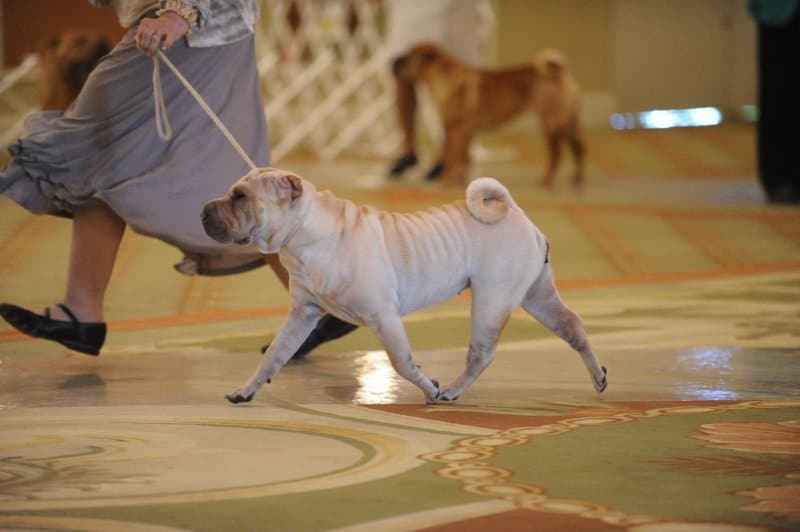Points to Consider When Judging the Chinese Shar-pei
My intention is not to expound on every aspect of the Chinese Shar-Pei Standard. I’m sure you have read it for yourselves, and I know judges know how to examine a Chinese Shar-Pei. What I hope to do here is point out some peculiarities of the Shar-Pei that may affect examination and evaluation.
Due to the deep set eyes and facial wrinkles, the Shar-Pei does not have good peripheral vision. Therefore, it is necessary to approach them from the front, putting your hand under the muzzle to examine the head. The small, dark, deep set eyes that the standard calls for may be more difficult to see, and any attempt to manually open them wider will have the opposite effect. PLEASE DO NOT TRY TO PRY THEM OPEN or they will slam them tightly shut. For some reason we’ve had numerous reports of that happening lately, and it is definitely counterproductive not to mention the lasting effect it may have on a young dog. Instead, hold up a piece of bait, jingle keys or rattle paper, etc. to get their attention.
It can be difficult to show the bite. With the characteristic head style the lip is often quite thick. It is best to allow the exhibitor to show it. Keep in mind that the struggle to show the bite can be unpleasant for the dog, particularly a less seasoned exhibit. They may completely lose their stack, so exhibitors appreciate it if they are given a moment to restack the dog. Alternatively, you may opt to check the bite at the end of your hands on.
Not much can be hidden on the Shar-Pei, so it’s not really necessary to spend a lot of time with hands on. However it’s a good idea to check coat texture and tail set while the dog is on the ramp. These are two of the distinguishing features of the breed, and are often overlooked. You can best determine coat texture by running the back of your hand from back to front. The coat will be harsher on a mature exhibit than on a puppy.
Many Judges and breeders alike confuse tail set with tail carriage. The tail must come over the back, but can be carried in a sickle style, a loose curl over the back and to either side, or a coin tail as seen on the pug. More important than the tail carriage is the extremely high set, on a flat croup, exposing a slightly up tilted anus. A tightly curled tail can sometimes fool the eye, lessening the appearance of a low set and/or an incorrect croup. Therefore it’s best to feel the croup and the set on of the tail at its base.
While not mentioned in the general appearance section of the standard, most consider the rise in topline to be one of the major distinguishing features of the breed. The topline should have a dip behind the withers and should rise slightly to the broad flat croup and extremely high tail set. Keep in mind, the rise is a steady incline from the dip behind the withers to the set on of the tail. It should not be the result of a sway back, a faulty croup or longer hind legs than front legs. It is not uncommon for the dog or handler to distort the topline when the dog is hand stacked, so it is best to observe it on the go around.
The Shar-Pei Standard, like the majority of AKC standards, calls for moderate rear angulation. Moderate is obviously a very subjective adjective. However, the standard also calls for well laid back shoulders, good reach and strong drive. There must be adequate rear angulation to balance well laid back shoulders and provide proper reach and drive. I believe you will see more under than over angulation, but neither is correct. We don’t want a Chow rear, nor do we want a German Shepherd rear. Movement should be clean coming and going, tending to converge on a center line of gravity at a vigorous trot. Side gait should be shown at a trot (not a flying trot), and should demonstrate good reach and drive. The standard emphasizes that PROPER MOVEMENT IS ESSENTIAL.
Movement should be clean coming and going, tending to converge on a center line of gravity at a vigorous trot. Side gait should be shown at a trot (not a flying trot), and should demonstrate good reach and drive. The standard emphasizes that PROPER MOVEMENT IS ESSENTIAL.
In part, the temperament is described as scowling, sober, snobbish, independent and somewhat
standoffish with strangers, so don’t expect a lot of animation from a Shar-Pei. We Americans have not made that a high priority in our breeding programs. Just know that when you do encounter one that is totally oblivious to your attempts to get expression, that it is correct per the standard.
Thank you for your interest in the Chinese Shar-Pei. I hope this helps you understand some of the idiosyncrasies of this great breed.
For more information, on everything Shar-Pei, contact: www.cspca.com.
If you would like to arrange for mentoring or find a seminar you can contact me directly at [email protected] or 217-528-8374.
Points to Consider When Judging the Chinese Shar-pei
From the February 2019 Issue of Showsight. Click to subscribe.
Are you looking for a Chinese Shar-Pei puppy?
The best way to ensure a long and happy relationship with a purebred dog is to purchase one from a responsible breeder. Not sure where to begin finding a breeder?
Contact the National Parent Club’s Breeder Referral person, which you can find on the AKC Breeder Referral Contacts page.
Want to help rescue and re-home a Chinese Shar-Pei dog?
Did you know nearly every recognized AKC purebred has a dedicated rescue group? Find your new best friend on the AKC Rescue Network Listing.
Chinese Shar-Pei Breed Magazine
Showsight Magazine is the only publication to offer dedicated Digital Breed Magazines for ALL recognized AKC Breeds.
Read and learn more about the intelligent Chinese Shar-Pei dog breed with articles and information in our Chinese Shar-Pei Breed Magazine.
Error embedding FlippingBook shortcode, please check the flipbook url. (https://digital.showsightmagazine.com/view/629815/)









